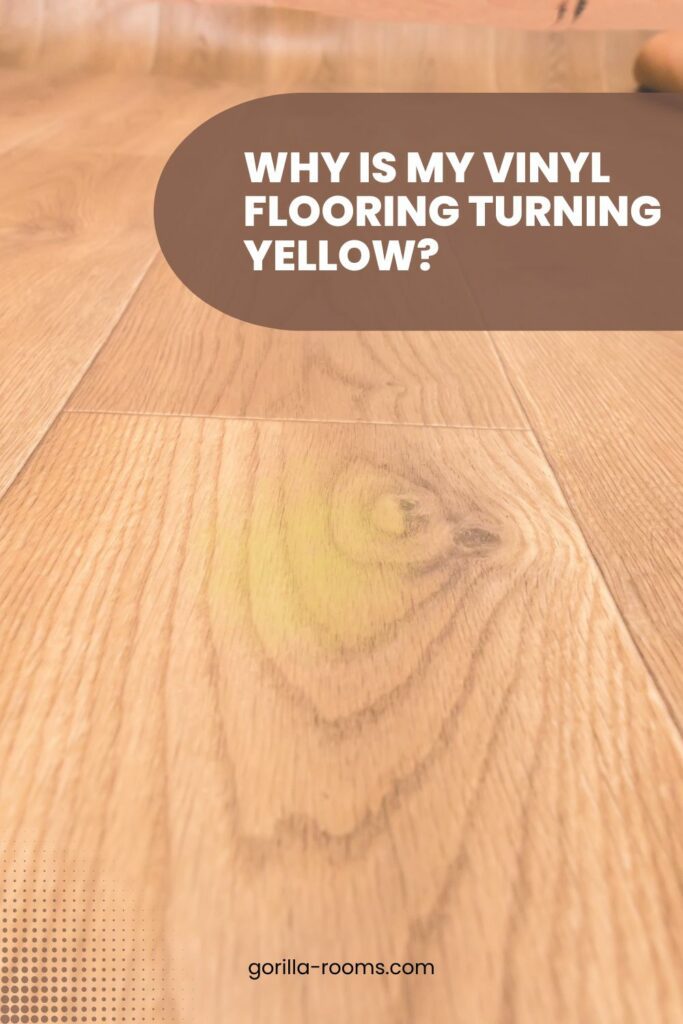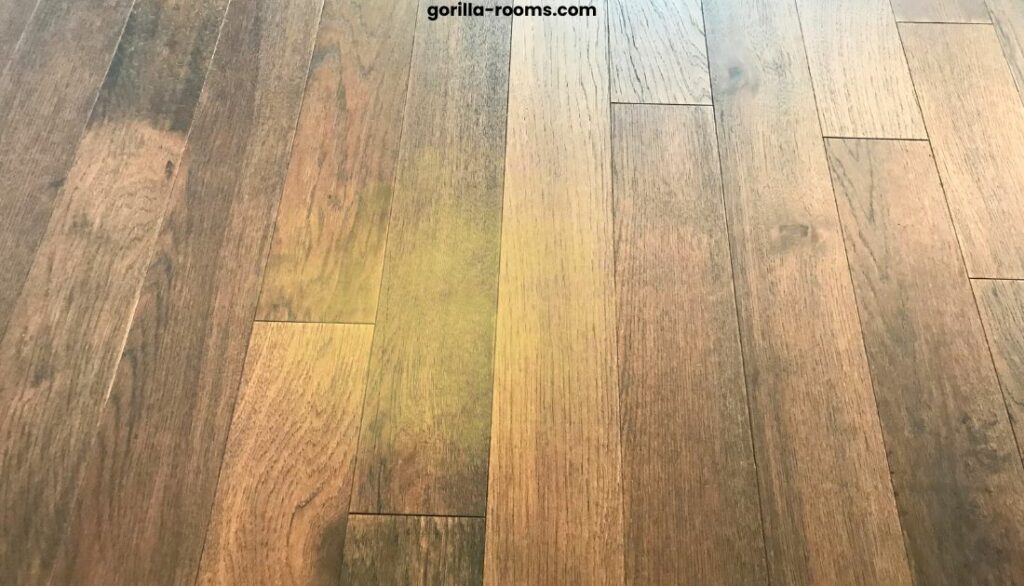Vinyl flooring is a fantastic choice for bathrooms and kitchens, but one problem you might notice with your vinyl flooring is that it might change color or turn yellow over time, especially in places like under the rugs or furniture.
Vinyl floor yellowing can be cause by rug pads, moisture, mold, continuous exposure to sunlight, or adhesives used during installation.
This guide will cover why cause vinyl flooring turns yellow and how to deal with yellow spots on the vinyl floor.
Why Is My Vinyl Flooring Turning Yellow?

Yellowing of vinyl flooring can happen due to several reasons.
1. Rug Pads
The vinyl floor includes several chemicals that give it its sheen. These reactions can take place with synthetic and natural rug pads and rubber to discolor them.
I have also placed rug pads in my home on vinyl floors, and it is normal to place rugs under the sitting area.
Furthermore, the floor below these rugs is not cleaned regularly. So, within a few months, those rug pads react with vinyl flooring and discolor it.
If these stubborn stains are left for an extended period, they may sometimes affect the bottom surface of the vinyl flooring.
Now that the affected area has deteriorated, you must replace the damaged area of the floor.
2. Improperly Applied Adhesives
It is essential to choose an appropriate glue; if you do not have sufficient knowledge about an optimal adhesive, get in touch with the manufacturer.
The vinyl floor is stained yellow by a reaction between a poor adhesive and vinyl. In most situations, it will discolor your floor, making it seem terrible, and you will need to replace the whole floor.
3. Chemical Reactions
Discoloration might occur when vinyl flooring comes into touch with certain rubber materials. Yellow spots are visible when lifting a rubber-backed area rug, the kitchen island wheels, or some furniture pieces.
Yet, this yellowing happens when you keep furniture or carpeting in the same location for an extended period. Changing its location or avoiding rubber-backed devices on vinyl floors may easily prevent the issue.
4. Dog Pee
Although vinyl flooring is water-resistant, you may wonder how dog urine would impact it. Neither dog urine nor any other liquids will harm a vinyl floor.
But, I have observed that when my dog urinates on a rug, the urine is absorbed by that rug and touches the floor’s surface.
It will result in viral or bacterial infection and a foul odor spreading across the space. So, do not let your dog urinate on the rug, particularly on a vinyl floor.
Most people would just vacuum over the surface and leave the carpeting as is. Moreover, urine eventually reacts with chemicals to leave permanent stains.
5. Direct Sunlight
Sun damage is a primary factor in yellowing on the vinyl floor. Long-term exposure to sunshine or high temperatures causes areas to fade and develop a significant color contrast.
Some of the most common places to see this sort of discoloration is next to the fireplace, as well as patio doors and wide windows that get plenty of sunshine.
Related Post: HOW TO MAKE PLANK VINYL FLOORS SHINE?
How to Remove Yellow Stains from Vinyl Flooring

If you follow the procedures below carefully, you should be able to get rid of the yellowing in your vinyl flooring for good.
Be cautious not to use acidic cleansers or a technique that will harm your home’s inhabitants. Choose a chemical that everyone will feel comfortable with, as certain compounds cause allergic responses.
1. Homemade Lemon And Soda Solution
Common ingredients may be found in even the smallest convenience store. They can effectively remove a variety of stains, including discoloration or yellowing on the vinyl floor.
- You can make the solution with a paste comprised of a glass of bread soda, and 1/4 cup of lemon juice should be prepared for this use.
- You must wait until the soda dissolves and becomes the required consistency.
- After that, apply the resultant mixture to the stains or rub it into a larger contaminated area before letting it stand.
- Before wiping, it requires a minimum of 10-15 minutes. Use a clean, wet towel to remove dirt and paste off the floor.
2. A Solution Of Bleach And Water
The combination of bleach and water may be used to fade the yellowing of the floor. You’ll need a bucket, rubber gloves, water, and bleach to create this solution.
- Mix three parts water with one part bleach, depending on the area you need to clean.
- Increase the bleach dosage and follow the same technique if you are unsatisfied with your results after the first procedure.
- If you observe a result, repeat the process multiple times to ensure that the stain completely disappears.
3. Dish Soap
Combining dish soap with water is an efficient method to clean vinyl flooring when required. I personally use this technique for a thorough cleaning, particularly for deep dirt:
- Stir together one gallon of warm water and one cup of apple cider vinegar. Apple cider vinegar is safe for use on floors and other surfaces.
- Add one spoonful of dish soap to the mixture. Dish soap may dissolve and wash away dirt.
- Nylon scrub bristles on a mop might help you get a better clean.
4. Mineral Spirits
- Fill the spray gun with mineral spirit and spray it on the damaged parts. To remove the yellow stain, scrub it vigorously.
- Replace the towel and massage until the yellow is gone if the stain is stubborn.
- You’ll notice that the fabric has absorbed the liquid while the floor has returned to its previous color.
- Clean the floor with a damp cotton towel, then vacuum the place until the mineral spirits are no longer detectable.
5. Rejuvenate Vinyl Floor Cleaner
If you’d like to use a solution made exclusively for vinyl flooring, I suggest Rejuvenate Vinyl Floor Cleaning.
This non-toxic cleaner eliminates filth, stains, and chemical residue. Your floors will appear brand new once more right away, and no residue will be left behind!
- Sprinkle the vinyl flooring.
- Thoroughly mop.
- Dry afterward.
Tips to Prevent and Remove Discoloration
In most circumstances, after removing yellow stains from your vinyl flooring, they may reappear; if you haven’t experienced them yet, take these steps to avoid experiencing them again and again.
1- Sweep Often
A soft-bristled broom should always be available for sweeping. You can keep the vinyl floors looking cleaner for much longer if you can spare a minute each day to sweep them.
When there is a greater quantity of dirt on the flooring, it is much easier to cause scuff marks and discoloration.
2- Clean The Subfloor Well Before Installation
Using the wrong type of glue or bits of glue from a previous floor installation can be bad. Not completely removing the glue might complicate the installation of the new floor and result in an uneven surface.
Vinyl may eventually become yellow as a result of the new adhesive’s chemical interaction with the remains.
The easiest approach to prevent this is to carefully read the manufacturer’s requirements and stick to the suggested items. It is essential to thoroughly clean the subfloor so that no remains of the previous glue remain.
3- Vacuum Weekly
Vinyl flooring may certainly be cleaned using a vacuum cleaner on a weekly basis. So be sure to avoid using carpet attachments at all costs since they can potentially harm the flooring.
4- Don’t Mop Often
Vinyl flooring may withstand moisture better than other flooring options but is not completely waterproof. So, mop only when absolutely essential.
It may weaken the underneath adhesive and impair the vinyl coating. Always completely dry the floors after mopping.
5- Preserve the Finish
Your best choice is to use a particular vinyl cleaner, such as Rejuvenate Vinyl if you want to keep vinyl flooring’ glossy sheen.
6- Using The Right Window Coverings
In order to avoid sun spots, a kind of irreversible discoloration, the vinyl flooring must be replaced or removed.
To lessen the impact of UV radiation, shut your windows and doors throughout the day and use high-quality window shades like solar screens.
I prefer installing curtains to optimize protection depending on how much sunshine enters my home.
7- Don’t Steam Mop
Your vinyl flooring may stretch, flex, or bubble if you use a lot of heat. Vinyl flooring cannot be cleaned using steam mopping, despite it being a practical and hygienic method.
8- The Milder, The Better
Bleach and harsh chemicals may harm vinyl flooring. The cleaner the solution, the softer and gentler, the better. It’s wise to look for business floor cleaners made especially for vinyl whenever possible.
Video Guide:
Conclusion
Vinyl flooring is one of the best long-lasting flooring options. But sometimes, it can leave yellow stains that look so weird.
Vinyl flooring can change color or yellow for a number of reasons, including a lot of foot traffic, floor accessories and furniture that are left standing, sun exposure, and the flooring’s age.
Keeping the above tips in mind will help you keep the floor material’s bright shine and get the most use out of it. I hope you enjoy this article and share it with your friends to help them clean their vinyl floors that are turning yellow.
FAQS
Can You Use a Magic Eraser On Vinyl Floor?
Yes, you can remove scuffs and stains from vinyl flooring with a magic eraser. But, you should apply it carefully since if applied too roughly, it may potentially damage the vinyl’s sheen.
Will Vinegar Damage Vinyl Floors?
Vinyl flooring may be cleaned using vinegar, a natural cleanser. Nevertheless, it should be used cautiously and diluted with water since it may eventually peel the floor’s protective layer, causing discoloration and damage.
Can I Use Pine-Sol On Vinyl Floors?
Popular all-purpose cleaner Pine-Sol may be used on vinyl flooring as well. To minimize any residue accumulation, it is crucial to dilute it with water as directed by the manufacturer and to completely rinse the floor after cleaning.
Related Post:

